Pomsky Dog Breed, Temperament, Training and Diet
What happens when a large dog meets a small dog? We get the Pomsky.
The cute little Pomsky dog proves wrong the naysayers who insist that different sized dogs cannot procreate. The resulting puppies are adorable if they breed in the right conditions. Here is what you need to know about the Pomsky’s temperament, grooming, health concerns, training requirements, and exercise needs.
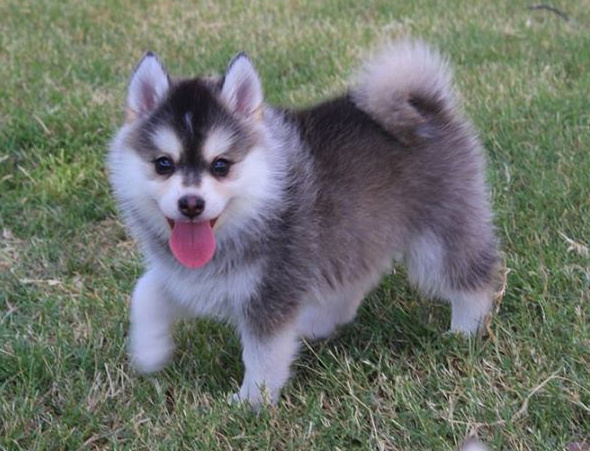
Pomsky Dog History
1. Pomsky Origin
The Pomsky has a short but exciting history. Here’s more about this unusual little crossbreed.
One of the Pomsky’s parents is the Siberian Husky, a sturdy, hefty dog bred by the Chukchi people of Siberia, primarily for hunting. Because of their 40-50 pound size, they made perfect sledging dogs. Breeders first introduced them in that role in 1908.
The Pomsky’s other parent, the Pomeranian, is the total opposite in size to the Siberian Husky. But like the Husky, it’s also a Spitz type breed. Known as the ‘dwarf-spitz’, it originated in the Polish-German region of Pomerania and was the favourite dog of the British Royalty.
The Pomsky came to be in 2009 when a user on just answer.com posted a question to Dog Health about the mental stability of a Pomeranian -Siberian Husky mix. The vet who answered, Dr Scott, felt that it was unlikely to work out. But the idea of crossing the two breeds materialised nonetheless.
The name Pomsky became a lasting trend. People began to put Pomsky pictures up on the internet. Whether they were photos of real puppies didn’t matter because the idea spread. One of the most famous photographs was one of a dog named Tequila by Swedish photographer Tommie Olson.
Tequila’s picture caught the attention of Buzzfeed’s editors by early February. Editor Peggy Wang felt that it could go viral. She posted an article entitled ‘Pomsky – the cutest designer dog breed ever ‘. At the time, the Pomsky was a mere urban legend. People chose to believe the myth and Peggy’s article went viral, with over 15000 views.
2. The First Pomsky Breeders
Tressa Peterson, a recognised breeder, saw a photo of the mislabelled Tequila ( labelled a Finnish Laphund) and became fascinated with the idea of a Siberian Husky-Pomeranian mix.
Her interest turned into an obsession. She spent the next year researching the possibilities of cross-breeding the two species. Her Friend, Joline Phillips, introduced her to an owner of a female Husky, Tabetha Ruhstorfer.
Tabetha allowed her Husky to breed with Tressa’s Pomeranian and the mating resulted in the first litter of Pomskys. The Husky conceived them through the process of artificial insemination.
Pomsky Dog Appearance
The Pomsky’s a crossbreed, so it’s appearance is unpredictable. Note that it has earned the name ‘Huskenarian”. Most Pomskys resemble their Siberian Husky parents but are smaller.
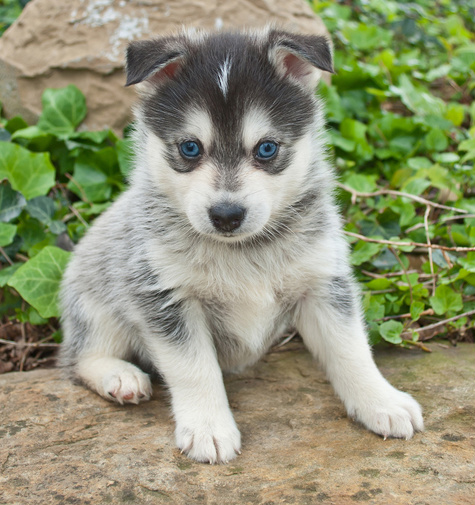
This dog has a medium-sized head that’s well-proportioned to its body. It has a sharp, aligned muzzle. Owing to its husky heritage, it has almond-shaped eyes. These are expressive and can be blue, like its Husky parents. Like the Pomeranian’s, they might be brown or hazel.
Like its Siberian Husky parents, the Pomsky has a curled tail. Its straight coat, like both its parents’, is soft and fluffy. It may have colours like those of the Siberian Husky’s, which are either white, black or both. It may also have colours of the Pomeranian’s (orange, sable, brown, white, or tan). It can also have an attractive, all-white colour with various markings.
Though the Pomsky has a short coat, it’s dense. It’s prone to matting if not carefully brushed. You may have to remove mats from its tail occasionally.
Altogether, the Pomsky has an engaging appearance. It has a perky stance that makes it alluring.
Pomsky Temperament
The Pomsky is a blend of two dog breeds and would have the traits of both. We outline what they are so that you can better understand your pet.
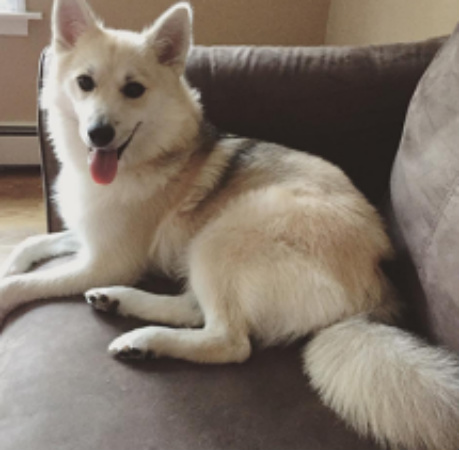
1. Siberian Husky Behaviour
The Pomsky inherits some of the Siberian Husky’s character traits, so it is intelligent and energetic. A sociable animal, it’s excellent for children, adults and other pets.
Owners will need to be firm with their Pomsky dogs and not allow them to exert dominance. Not being assertive may cause their Pomskys to become destructive.
2. Inherited Traits to the Pomsky
A Spitz-like the Pomeranian is typically full of energy and needs lots of play time. Not giving it due attention may cause them to show bad behaviour like chewing.
3. Pomeranian Temperament
A Pomeranian is similar to a husky when it comes to temperament, which is probably why a blend of both breeds works well. Pomeranians are energetic and on the go. Owners must also rein them in. They may learn bad habits, which can lead to offensive behaviour. Owners may find it difficult to change these responses, and train them.
A bane of the Pomeranian temperament is that it tends to bark shrilly and loudly. The habit can become annoying to owners and their neighbours if there are no measures to check it. It is a symptom of the Small Dog Syndrome. Although it protects owners, it may offend neighbours. The habit is both a blessing and a curse.
4. Comparing the Pomsky
The Pomsky may have the Pomeranian’s irritating bark, but inherit its loving and protective nature. Hence, it will need training so that it won’t develop the Small Dog Syndrome. Owners should take steps to assert themselves over their puppies.
Temperament of the Pomsky
Having taken into account the traits of the Pomeranian and the Husky, you’ll understand that the Pomsky will have the characteristics of both dogs. However, do note that each Pomsky will be different. What’s certain is that the dog will be energetic, loyal, and bond well with you.
Take the time to play with your puppy, as it will need a lot of attention. You will also need to expand its energy. Take care when introducing your dog to children, as unexpected behaviours may cause it to bark loudly or act out. Teach children not to tease or irritate dogs, whether or not they are Pomskys.
Choosing a Pomsky Puppy
The Pomsky is on a mission to charm dog lovers with its cuteness. But like all hybrids, its appearance is unpredictable. So saying, you’ll have to choose your Pomsky puppy wisely.
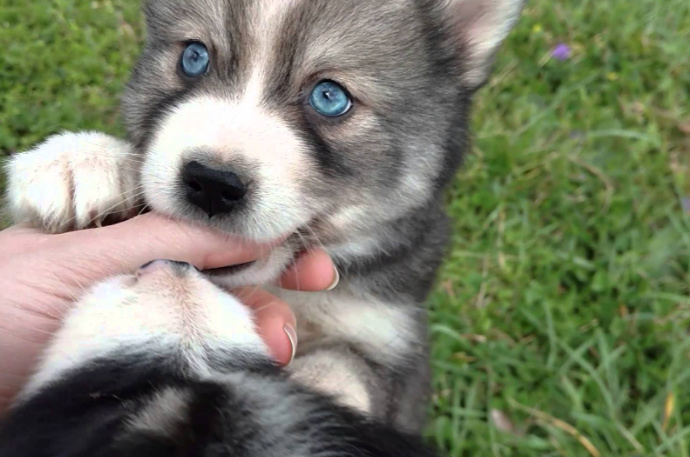
1. Size
A Pomsky puppy is too cute to be true, but its appearance is difficult to predict or ascertain.
It typically resembles their Husky parent. Like a Husky, it has a soft, polished grey-white-black coat. Its head and mouth look like a fox’s, and it has erect, triangular ears.
2. Character and Traits
Being Spitz-like dogs, the Pomeranian and Husky share similar characteristics despite a difference in size.
The mix of the two breeds means that the Pomsky is a free-spirited creature with a penchant for fun. It’s always alert and energetic. They’re not problematic but are mischievous. They have a propensity for getting into a little trouble, so do keep them in check.
Note that these gentle dogs make ideal family pets. Affectionate, loyal, and most of all, intelligent, you can potty train them quickly. Obedience training is not a problem either.
3. The Politics of Pure Breeds
The Pomsky is a regular dog like any other and behaves like all canines. However, it isn’t a recognised breed because it is a mix of two and not three dogs. A Pomsky puppy will not suit you if you are a lover of purebred dogs.
4. Shedding
Note that Pomskys tend to shed hair and may have bald spots on their bodies on occasion. You’d also need to clear your furniture of dog hair regularly.
Note that some of your loved ones may have allergies. There exists a myth that it’s hypoallergenic. The truth is that all dogs shed. The Pomsky’s double-coated, and will lose its inner coat seasonally. Before welcoming it home, make sure that your family members don’t have allergies.
5. Nature
Energetic and playful, Pomsky puppies need a lot of attention. Occupy their time with games and regular walks.
Don’t over-pamper them, as they’ll take advantage of your kindness. Note that Pomsky puppies, owing to their Pomeranian heritage, may suffer from the ‘Small Dog Syndrome.” They sometimes feel superior to other people or dogs.
6. Health Concerns
No dog, or human, is without faults. This truth applies to the Pomsky.
LIke its Husky parent, it may be prone to dysphasia, or hip displacement. They may also develop cataracts and skin troubles like dermatitis. A Pomsky may have a dislocated patella like its Pomeranian parent.
Generation matters when breeding hybrids. Health issues may occur after multiple generations; breeders shouldn’t breed the one generation of Pomskys after another because there is a high chance that puppies may have health issues.
House Training Your Pomsky Puppy
You will need to housetrain your Pomsky Puppy, lest your home becomes a mess. It’s not as daunting a task as it seems.
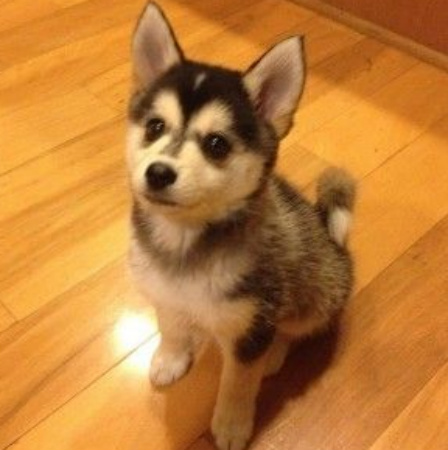
1. How long will it take to housetrain a Pomsky Puppy?
There isn’t a sure way to tell how long it will take to housetrain a Pomsky puppy. Some puppies will learn what to do quickly and signal that it’s time to go. Some will take a longer time. With patience and effort, puppies can sleep through the night without passing faeces and urine.
Small breeds like Pomskys have a reputation for being difficult to train. There’s an ongoing debate among trainers about size and breed habits. Many believe that it’s easy to get a big dog to become house-trained than a small one.
2. How long can your puppy control himself?
In general, the older a puppy is, the longer it can control its bladder. However, it’s still impossible to expect a four-month-old puppy to hold it for five hours at a go.
Start training your Pomsky puppy by gradually increasing the time between toilet breaks. Unless it’s bedtime, owners shouldn’t expect a young puppy to hold itself for too long.
3. Potty Training Your Puppy Outside
Most owners prefer their puppies to pee outside instead of inside the home. Bring your Pomsky puppy to a place you would like it to ease itself and stand there without disturbing it. If it eliminates within a few minutes, praise it and give it a treat. Don’t reward it if it eases itself at home. However, do not scold it, as there are times when it needs to relieve itself indoors.
Take the dog indoors if it doesn’t need to relieve itself, but keep it confined. Wait for another half an hour before taking it outdoors again. Keep doing this until your dog gets the message that it should relieve itself outdoors. Praise and treat it when it finally manages to do so.
4. Crate Training
Some trainers don’t like crate training as it involves keeping the dog confined. But it can be one of the best ways to house train your Pomsky puppy. Besides being a useful toilet training method, it gives the dog a space of its own.
Make sure that the crate is of a suitable size. It should be big enough for the dog to stand, stretch its legs, turn around, and lie down. Remember that dogs are clean creatures and won’t want to dirty the spots where they rest. That said, they may use any extra space to relieve themselves.
Once your dog gets used to the crate, it will tell you when it needs to go. You’ll realise this when it becomes restless.
5. Using Newspapers
You may live in an apartment and need your Pomsky to eliminate on newspapers. Training your puppy to do this is a breeze but must be consistent.
Keep your puppy in the area where you want it to ease itself. Lay out newspapers. Praise it when it eliminates, and gradually remove the paper, eventually leaving behind some on the spot it’s supposed to use.
Grooming A Pomsky
Grooming enhances a dog’s appearance and keeps it in good health. Here’s how to keep your Pomsky’s coat tidy.
1. Bathing
We bathe to keep ourselves clean and well-groomed, and so should our dogs. A Pomsky needs regular baths.
Bathing needs vary from one Pomsky to another. How often it should have a bath depends on the condition of its coat, how often it plays outside, and how dirty it gets. Typically, dogs should bathe every few weeks. Doing so too often would remove the essential oils that keep their coats shiny. That said, there shouldn’t be too big a gap between baths.
Use a gentle shampoo and cotton balls. Put your dog in the tub and soak it in warm water. Place a cotton ball in its ears to prevent water from entering them. Wet every part of its body.
As you apply shampoo, take care not to let soap enter its eyes. Rinse the shampoo off with warm water. Follow this with a conditioner if you wish.
2. Blow out the undercoat
Once you’ve finished bathing the dog, towel-dry it. Use a blow dryer to blow out its undercoat. Comb its hairs out with a slicker brush. Use a fine-toothed comb to pull out the remainder of its soft hairs. Use grooming clippers to shear excess hairs. Make sure that you don’t overdo this as your dog’s coat will become too short.
3. Nail Clipping
Many dogs hate nail clipping because it’s painful. Owners sometimes make the mistake of cutting the nail down to the quick. That, of course, causes bleeding.
Grinding is an alternative to using nail clippers. It works best for dogs which don’t enjoy the nail cutting process. It allows you to remove the excess nail without affecting the quick. Grinding smoothens the nails as well.
4. Shaving The Paw Pads
This process is an optional but highly recommended. It’s useful for hairy dogs which may bring grass and dirt into their homes. Ensure that you clip off the excess hair between the pads.
5. Ears
Dog odour emanates from the ears. Note that these are part of the mammalian excretory system. It’s essential to keep them clean.
Fold your dog’s ear backwards. Clean the outer ear with a mild ear solution and a cotton swab. Move toward the inner ear, taking care not to probe. Remove any waxy substance.
How To Reduce Annoying Pomsky Behaviours
No dog is perfect. Even the tamest dog is occasionally disruptive. Here are some of the Pomsky’s most annoying behaviours and how to curb them.
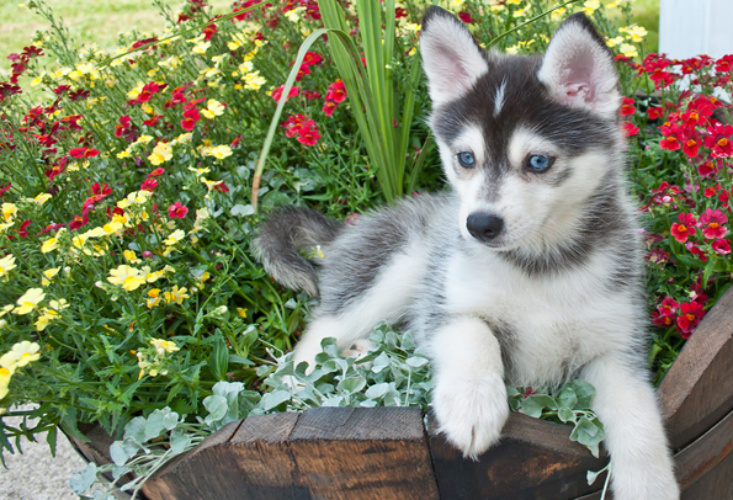
1. Barking
One of the most annoying dog behaviours is barking. The Pomsky’s Pomeranian heritage makes it particularly prone to making unwanted doggy statements. What’s most irritating is that its bark is rather shrill.
You’ll need to stop it. To do so, find out the cause of the barking. Then, remove the stimulus and ignore the dog. Your dog will understand that it should stop.
Alternatively, teach your dog to stop barking on command. To do this, use the words ‘no speak’. Close its muzzle gently and reward it when it obeys you.
2. Jumping
Dogs feel relieved and excited when they see their owners come home. They jump up on them in excitement. The arrival of guests thrills them, and they respond by leaping around.
Charming as this behaviour is, it’s unacceptable. Also, dogs leave painful scratches on the legs when they jump.
To stop your Pomsky’s over-excited leaps, ignore it. Give it attention only when its feet are on the ground.
3. Chewing
This habit is part of a puppy’s growing process. Also, note that dogs chew when they are bored.
To break this habit, make sure that your Pomsky’s gainfully occupied. Replace your slippers with chew toys. Dog-proof your home, and keep chewable materials out of Fido’s way.
4. Separation Anxiety
Dogs hate it when their owners leave home. They become bored and start exhibiting destructive behaviours, such as chewing (above) and digging.
Get your dog used to you not being at home. Bid your dog goodbye when you leave for work, but don’t make a fuss. Let it understand that it’s not a big deal if you go away for a short time.
You may also play soft music for your dog. Soft music assures it of your presence and keeps it comfortable.
5. Begging
Dogs are perpetually hungry. They beg for food even when they don’t need it. You’ll feel embarrassed in front of your guests if it asks for food at the table.
Never reward begging behaviour, no matter how petulant your dog is. That teaches the dog that begging gets it what it wants. Try feeding your dog at the same time that you eat. It will be too full to ask for any more food.
6. Digging
Your dog may feel restless being all alone in the yard. An unoccupied dog is a destructive one. You may find your precious plants uprooted when you reach home.
Give your Pomsky a spot to dig and allow it to roam only in that area. Though that area of your garden may look ugly, at least the rest of it will remain intact.
7. Soiling
This behaviour is as unhygienic as it is annoying. But it isn’t always easy for your dog to control.
Rule out any medical issues. Dogs may soil if they have digestive problems. Older canines may suffer from Cognitive Dysfunction, much like humans.. You’ll need to re-train your dog in the same way you did when it was a puppy.
8. Mouthing
Dogs mouth their owners to show their desire to play. While this is cute, it may lead to more aggressive behaviour.
Let out a yelp when your dog mouths you, and let your hand go limp. That will startle your Pomsky and prevent further biting.
9. Humping
Humping is normal doggy behaviour. That said, it is embarrassing.
Make sure that you spay your dog. Distract it when it humps and uses the ‘sit’ command.
10. Aggression
Is your Pomsky aggressive to people or other dogs? The good news is that you can do something about the behaviour.
Avoid situations when there may be aggression. If your dog is aggressive towards other dogs, avoid the targets of its behaviour when you go out for walks.
Also, early socialisation plays a part in reducing the behaviour. Take your Pomsky puppy out for regular walks and allow it to meet other dogs.
Pomsky Nutrition
Pomskys are a mix of two Spitz breeds, so they have shared ancestry. Their nutritional needs are similar.
1. The Pomsky’s Nutritional Needs
The Pomsky is a relatively new breed, so there isn’t much information about its dietary needs. We gather information about its nutrition from its parents, the Husky and the Pom. Ask the breeder if your Pomsky’s parents have existing health issues.
When planning your Pomsky dog’s diet, consider that its Husky parent is prone to Hip Dysplasia. The good news is that the condition isn’t typical among them. Huskies may be inclined to responsive dermatosis, and it’s not known if this skin problem is hereditary.
Then consider its other parent, the Pomeranian. Poms are prone to luxating patellas (dislocated kneecaps). They may develop dental problems as well.
What all this means is that the Pomsky, like other dogs, needs quality food.
2. How Often Should A Pomsky Eat?
Dogs have varying metabolic rates, depending on their sizes. The Pomsky, being a smaller dog than the Husky, has a faster metabolic rate. It needs about 20 calories per pound of body weight, whereas Huskies need about 40 calories per pound.
Calculate how much your Pomsky should eat. Most food companies measure the number of calories in their kibble per cup. Make comparisons between different foods before deciding which is best for your dog.
3. How many calories does a Pomsky need?
Though sizes may vary, a Pomsky should weigh about 25 pounds. Feed it about 780 calories. You will probably need to reduce this amount if you had neutered it, or if it is sedentary. Calorie needs differ from one dog to another.
Every owner frets over his dog’s weight. Put your hand on your Pomsky’s ribs. You ‘d need to put your Pomsky on a diet if you can’t feel them.
4. What should I feed my Pomsky?
Contrary to what you may have heard, protein, in appropriate amounts, doesn’t cause health problems. Experts advise that animal protein is more nutritious than plant protein for dogs. Fish, eggs, chicken, lamb and beef are excellent protein sources.
Dog food manufacturers understand the need for an animal to stay healthy. They produce dog food with lots of vegetable proteins. While your dog needs these nutrients, they alone aren’t enough. Include animal proteins in your Pomsky’s diet.
5. Get Fat
No, this doesn’t mean stocking up on carb-rich bread or fatty meat. Dogs, like humans, need good sources of fat. Fat is essential in a dog’s diet as it provides Vitamins A, D, E, and K. Fish oil, from tuna and salmon, is rich in Omega 3 and 6 and will benefit your pet.
6. Low to Moderate Carb
Carbs are essential energy boosters, but your dog doesn’t need an excess of them. Many dog foods contain more carbs than necessary, so do read food labels.
7. Don’t buy foods with artificial preservatives
Manufacturers have a key objective – to sell their products. Responsible ones bear dogs’ health in mind.
However, many fill dog food packets with artificial colours and ingredients to make their products appealing. Do take note of what a bag of kibble contains before buying it.
Pomsky Breeding
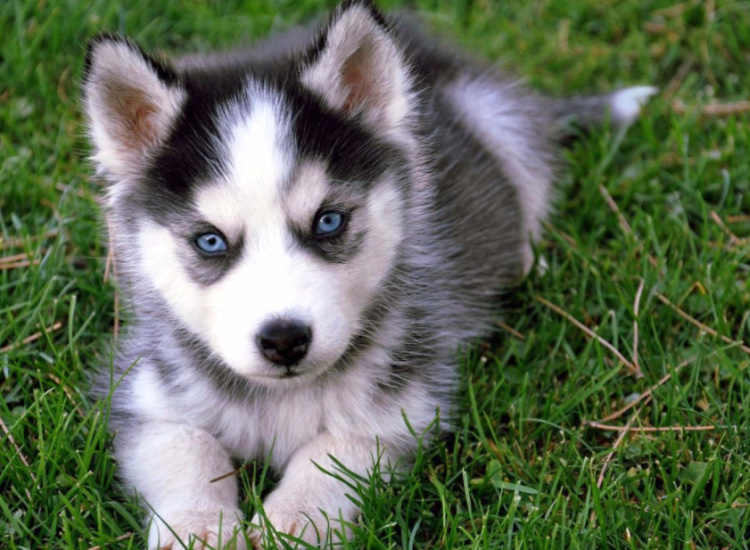
Designer dogs are all the rage these days, and the Pomsky is one of the most popular of these to date. But with one dog being much smaller than the other, how would you get them to breed? The answer- the process involved is painstaking.
Breeding dogs, of vastly different sizes, is difficult. That said, it isn’t impossible. You would have to do it via the process of artificial insemination. Also, you’d need the help of a vet.
You’d need to be precise. It’s best to breed a male Pomeranian with a female husky, owing to the disparity in sizes. A female Pom will have difficulty whelping healthy Pomsky pups.
Collecting the sperm is an adventure in itself. You’d still need to use a female in heat to entice the male to mate. You’d then have to use a receptacle to collect the male’s semen. Of course, timing is of the essence.
Then, you’d need to get semen samples from the male and get a vet to impregnate the female artificially. Note that the best time to insert the first specimen is four days before its ovulation. The vet will use the second sample 48 hours after the female’s ovulation.
The complicated process explains why Pomskys are more expensive than other breeds.
Pomsky Health Problems
The Pomsky hasn’t been around for very long, so we’d get insight into their health conditions from those that trouble Huskies and Poms.
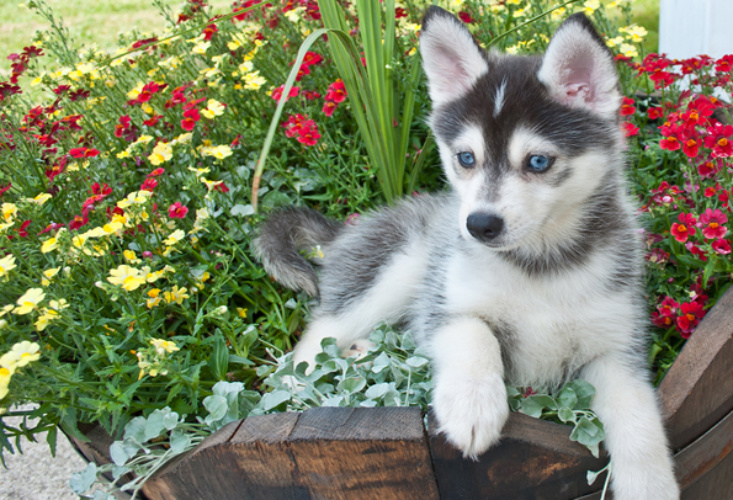
Many of them suffer from dental disease. Periodontal disease is relatively common in Pomskys, so regular checkups are essential.
They may inherit the problem of hip dysplasia, or dislocated hip joints, from their Husky parents. Symptoms of this condition include lameness, bunny hopping, and difficulty climbing stairs.
Like Siberian Huskies, the Pomsky may suffer from Entropion or an inward-turning eyelash. It can cause discomfort because the eyelash no longer prevents dirt from entering the eyes. Symptoms of this condition are ulcers on the outside of the eye, scarring, pain, and of course, vision difficulties.
Siberian Huskies sometimes suffer from Follicular Dysplasia or hair loss. Dogs which suffer from this condition will have discoloured, fragile hair.
Like Pomeranians, the Pomsky may suffer from Hyperthyroidism and Cushing’s disease. If your dog has an over-active thyroid, it may experience hair loss and weight gain. It may have a dry coat and not bear cold weather well.
Pomeranians, like other small dogs, may have collapsed trachea, which will cause breathing difficulties.
Tricks To Teach Your Pomsky Dog
Pomskys are intelligent dogs, and owners should let them show off this trait. Here are a few tricks you can teach your pet.
1. High Five
Get your dog to sit. Reward it and hold a treat out in front of you. Tap one of its paws and say ‘Hi-Five’. When your dog touches the hand with the goodie, catch its leg with your free hand.
Praise your dog and repeat the process. Your aim should be to get your dog to raise its paw without you tapping it when you say ‘Hi-Five”. Remember to use the gestures consistently.
2. Kiss
This trick is an easy one to teach, as dogs seldom have problems licking their owners. Leave a treat on your face and say “Kiss”. Some dogs will do so automatically. You should do this trick quickly enough so that the dog only taps you with its nose instead of doing so.
To make it ‘kiss’ you quickly, point to your cheek. When your Pomsky touches your cheek with its nose, pull away and reward it. Avoid this trick if your Pomsky tends to bite.
3. Dance
Small breeds like the Pomsky have few problems with this trick but avoid it if your dog has hip dysplasia.
Get your dog to sit, then hold a treat up over, or behind its head. Say ‘dance’. Repeat this until it stands on its hind legs. Remember to use the same gestures consistently.
Move the treat around your Pomsky’s head until it turns in a circle. Then reward it. Do this trick until it manages to balance as it spins.
In all, the Pomsky is a welcome addition to any home. Although it has a few health issues, these are manageable if addressed early.With proper house training and patience, this sometimes noisy dog will make an excellent companion. The Pomsky will be a lifelong friend if you bear this guide in mind.
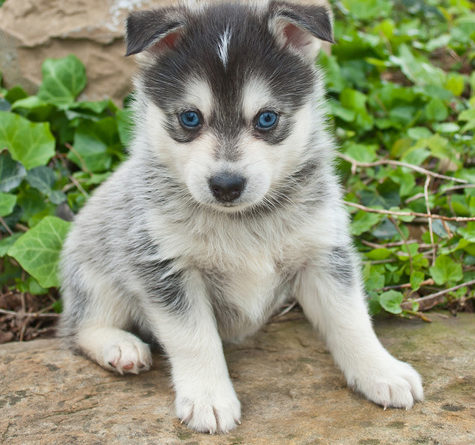
Training,
Temperament and
Diet are very important factors for a pomsky dog to make such rare breed easily available by working on this 3 important factors to make such dog breed strong.